Tourists’ Perceptions Regarding Traveling for Recreational or Leisure Purposes in Times of Health Crisis
Abstract
:1. Introduction
2. Literature Review
2.1. The Impact of the Pandemic Crisis Caused by SARS-CoV-2 Virus on the Tourism Industries
2.2. Tourists’ Perception of Travel in the Health Crisis and Beyond
3. Materials and Methods
4. Results
- Willingness to travel in 2021 in the context of the current pandemic;
- Accommodation units must comply with health protection regulations;
- Food units must comply with health protection regulations;
- Staff should be vaccinated;
- The other tourists should be vaccinated.
5. Discussion
6. Conclusions
Author Contributions
Funding
Informed Consent Statement
Data Availability Statement
Acknowledgments
Conflicts of Interest
References
- European Council of the European Union. Available online: https://www.consilium.europa.eu/ro/policies/coronavirus/ (accessed on 1 April 2021).
- Walmsley, T.; Rose, A.; Wei, D. The Impacts of the Coronavirus on the Economy of the United States. Econ. Disasters Clim. Chang. 2021, 5, 1–52. [Google Scholar] [CrossRef] [PubMed]
- Goodrich, J.N. September 11, 2001 Attack on America: Impact on Tourism Security. J. Travel Tour. Mark. 2002, 11, 1–12. [Google Scholar] [CrossRef]
- McKercher, B.; Chon, K.K.S. The Over-Reaction to SARS and the Collapse of Asian Tourism. Ann. Tour. Res. 2004, 31, 716–719. [Google Scholar] [CrossRef] [PubMed]
- Schmude, J.; Karl, M.; Weber, F. Tourism and Terrorism: Economic impact of terrorist attacks on the tourism industry. The example of the destination of Paris. Z. Wirtsch. 2020, 64, 88–102. [Google Scholar] [CrossRef]
- UNWTO. World Tourism Organization and International Labour Organization Economic Crisis, International Tourism Decline and Its Impact on the Poor; UNWTO: Madrid, Spain, 2013. [Google Scholar] [CrossRef]
- Worldometer. Available online: https://www.worldometers.info/coronavirus/ (accessed on 4 April 2021).
- UNWTO World Tourism Barometer (English Version). Available online: https://doi.org/10.18111/wtobarometereng (accessed on 4 April 2021).
- Steg, L.; Perlaviciute, G.; Van Der Werff, E.; Lurvink, J. The Significance of Hedonic Values for Environmentally Relevant Attitudes, Preferences, and Actions. Environ. Behav. 2014, 46, 163–192. [Google Scholar] [CrossRef]
- Wang, X.; Van der Werff, E.; Bouman, T.; Harder, M.K.; Steg, L. I Am vs. We Are: How Biospheric Values and Environmental Identity of Individuals and Groups Can Influence Pro-environmental Behaviour. Front. Psychol. 2021, 12. [Google Scholar] [CrossRef]
- Cavagnaro, E.; Staffieri, S.; Carrieri, A.; Burns, K.; Chen, N.; Fermani, A. Profiling for sustainable tourism: Young travellers’ self-transcendence values and motivations. Eur. J. Tour. Res. 2021, 28, 2810. [Google Scholar]
- Bratić, M.; Radivojević, A.; Stojiljković, N.; Simović, O.; Juvan, E.; Lesjak, M.; Podovšovnik, E. Should I Stay or Should I Go? Tourists’ COVID-19 Risk Perception and Vacation Behavior Shift. Sustainability 2021, 13, 3573. [Google Scholar] [CrossRef]
- UNWTO, COVID-19 Related Travel Restrictions A Global Review For Tourism 9th Report as of 8 March 2021. Available online: https://webunwto.s3.eu-west-1.amazonaws.com/s3fs-public/2021-03/210309-Travel-Restrictions.pdf (accessed on 4 April 2021).
- Gössling, S.; Scott, D.; Hall, C.M. Pandemics, tourism and global change: A rapid assessment of COVID-19. J. Sustain. Tour. 2020, 29, 1–20. [Google Scholar] [CrossRef]
- Uğur, N.G.; Akbıyık, A. Impacts of COVID-19 on global tourism industry: A cross-regional comparison. Tour. Manag. Perspect. 2020, 36, 100744. [Google Scholar] [CrossRef]
- Worldometer. Available online: https://www.worldometers.info/coronavirus/#countries (accessed on 7 April 2021).
- Davahli, M.R.; Karwowski, W.; Sonmez, S.; Apostolopoulos, Y. IThe Hospitality Industry in the Face of the COVID-19 Pandemic: Current Topics and Research Methods. Int. J. Environ. Res. Public Health 2020, 17, 7366. [Google Scholar] [CrossRef]
- Pusca, C.A. Should We Share Rights and Obligations with Artificial Intelligence Robots? In Lecture Notes of the Institute for Computer Sciences, Social Informatics and Telecommunications Engineering; Santos, H., Pereira, G., Budde, M., Lopes, S., Nikolic, P., Eds.; Springer: Cham, Switzerland, 2020; Volume 323, pp. 412–419. [Google Scholar]
- Belzunegui-Eraso, A.; Erro-Garcés, A. Teleworking in the Context of the Covid-19 Crisis. Sustenability 2020, 12, 3662. [Google Scholar] [CrossRef]
- Radulescu, C.; Ladaru, G.-R.; Burlacu, S.; Constantin, F.; Ioanăș, C.; Petre, I. Impact of the COVID-19 Pandemic on the Romanian Labor Market. Sustainability 2020, 13, 271. [Google Scholar] [CrossRef]
- Arimura, M.; Ha, T.V.; Okumura, K.; Asada, T. Changes in urban mobility in Sapporo city, Japan due to the Covid-19 emergency declarations. Transp. Res. Interdiscip. Perspect. 2020, 7, 100212. [Google Scholar] [CrossRef]
- Kim, K. Impacts of COVID-19 on transportation: Summary and synthesis of interdisciplinary research. Transp. Res. Interdiscip. Perspect. 2021, 9, 100305. [Google Scholar] [PubMed]
- Orro, A.; Novales, M.; Monteagudo, Á.; Pérez-López, J.-B.; Bugarín, M. Impact on City Bus Transit Services of the COVID–19 Lockdown and Return to the New Normal: The Case of A Coruña (Spain). Sustainability 2020, 12, 7206. [Google Scholar] [CrossRef]
- Barbieri, D.M.; Lou, B.; Passavanti, M.; Hui, C.; Hoff, I.; Lessa, D.A.; Sikka, G.; Chang, K.; Gupta, A.; Fang, K.; et al. Impact of COVID-19 pandemic on mobility in ten countries and associated perceived risk for all transport modes. PLoS ONE 2021, 16, e0245886. [Google Scholar] [CrossRef] [PubMed]
- Bartle, J.; Lutte, R.; Leuenberger, D. Sustainability and Air Freight Transportation: Lessons from the Global Pandemic. Sustainability 2021, 13, 3738. [Google Scholar] [CrossRef]
- Sun, X.; Wandelt, S.; Zhang, A. How did COVID-19 impact air transportation? A first peek through the lens of complex networks. J. Air Transp. Manag. 2020, 89, 101928. [Google Scholar] [CrossRef] [PubMed]
- Abu-Rayash, A.; Dincer, I. Analysis of mobility trends during the COVID-19 coronavirus pandemic: Exploring the impacts on global aviation and travel in selected cities. Energy Res. Soc. Sci. 2020, 68, 101693. [Google Scholar] [CrossRef]
- International Air Transport Association [IATA]. Annu. Rev. 2020. Available online: https://www.iata.org/contentassets/c81222d96c9a4e0bb4ff6ced0126f0bb/iata-annual-review-2020.pdf (accessed on 15 April 2021).
- Institutul National de Statistica (INS) Transportul Aeroportuar de Pasageri şi Mărfuri în Anul 2020/National Institute of Statistics (INS) Irport Passenger and Freight Transport in 2020. Available online: https://insse.ro/cms/sites/default/files/field/publicatii/transportul_aeroportuar_de_pasageri_si_marfuri_in_anul_2020_0.pdf (accessed on 15 April 2021).
- Kaushal, V.; Srivastava, S. Hospitality and tourism industry amid COVID-19 pandemic: Perspectives on challenges and learnings from India. Int. J. Hosp. Manag. 2021, 92, 102707. [Google Scholar] [CrossRef] [PubMed]
- Sibi, P.S.; Das, A.; Ashraf, M. Changing Paradigms of Travel Motivations Post COVID-19. Int. J. Manag. 2020, 11, 489–500. [Google Scholar]
- Yousaf, A.; Amin, I.; Santos, J.A.C. Tourists’ Motivations to Travel: A Theoretical Perspective on the Existing Literature. Tour. Hosp. Manag. 2018, 24, 197–211. [Google Scholar] [CrossRef]
- Roman, M.; Niedziółka, A.; Krasnodębski, A. Respondents’ Involvement in Tourist Activities at the Time of the COVID-19 Pandemic. Sustainability 2020, 12, 9610. [Google Scholar] [CrossRef]
- Păvăluc, C.; Brînză, G.; Anichiti, A.; Butnaru, G.I. COVID-19 pandemic and its effects on the tourism sector. CES Work. Pap. 2020, 12, 111–122. [Google Scholar]
- Cutler, S.Q.; Carmichael, B. The dimensions of the tourist experience. In The Tourism and Leisure Experience: Consumer and Managerial Perspectives; Morgan, M., Lugosi, P., Ritchie, B., Eds.; Channel View Publications: Bristol, UK, 2010; pp. 3–26. [Google Scholar]
- Jászberényi, M.; Miskolczi, M. Danube Cruise Tourism as a Niche Product—An Overview of the Current Supply and Potential. Sustainability 2020, 12, 4598. [Google Scholar] [CrossRef]
- Ito, H.; Hanaoka, S.; Kawasaki, T. The cruise industry and the COVID-19 outbreak. Transp. Res. Interdiscip. Perspect. 2020, 5, 100136. [Google Scholar] [CrossRef]
- Saarinen, J. Critical sustainability: Setting the limits to growth and responsibility in tourism. Sustainability 2014, 6, 1–17. [Google Scholar] [CrossRef] [Green Version]
- Persson-Fischer, U.; Liu, S. The Impact of a Global Crisis on Areas and Topics of Tourism Research. Sustainability 2021, 13, 906. [Google Scholar] [CrossRef]
- Sigala, M. Tourism and COVID-19: Impacts and implications for advancing and resetting industry and research. J. Bus. Res. 2020, 117, 312–321. [Google Scholar] [CrossRef] [PubMed]
- Dorobăţ, M.L.; Dobrescu, C.M. The Anthropic Impact in the North-Western Side of Leaota Mountains. J. Curr. Trends Nat. Sci. 2016, 5, 63–72. [Google Scholar]
- Lapointe, D. Reconnecting tourism after COVID-19: The paradox of alterity in tourism areas. Tour. Geogr. 2020, 22, 633–638. [Google Scholar] [CrossRef]
- Reitsamer, B.F.; Brunner-Sperdin, A. Tourist destination perception and well-being. J. Vacat. Mark. 2017, 23, 55–72. [Google Scholar] [CrossRef]
- Hurley, S. Perception And Action: Alternative Views. Synthese 2001, 129, 3–40. [Google Scholar] [CrossRef]
- Matiza, T. Post-COVID-19 crisis travel behaviour: Towards mitigating the effects of perceived risk. J. Tour. Futur. 2020. ahead-of-print. [Google Scholar] [CrossRef]
- Majeed, S.; Zhou, Z.; Lu, C.; Ramkissoon, H. Online Tourism Information and Tourist Behavior: A Structural Equation Modeling Analysis Based on a Self-Administered Survey. Front. Psychol. 2020, 11, 599. [Google Scholar] [CrossRef] [PubMed] [Green Version]
- European Commission. Eurobarometer The EP and the Expectations of European Citizens. Resilience and Recovery: Public Opinion One Year into the Pandemic. Available online: https://www.europarl.europa.eu/at-your-service/files/be-heard/eurobarometer/2021/spring-2021-survey/report.pdf (accessed on 11 June 2021).
- Seth Borko, Wouter Geerts, Haixia Wang The Travel Industry Turned Upside Down: Insights, Analysis and Actions for Travel Executives, McKinsey and Company, Skift Research. 2020. Available online: https://www.mckinsey.com/~/media/mckinsey/industries/travel%20logistics%20and%20infrastructure/our%20insights/the%20travel%20industry%20turned%20upside%20down%20insights%20analysis%20and%20actions%20for%20travel%20executives/the-travel-industry-turned-upside-down-insights-analysis-and-actions-for-travel-executives.pdf (accessed on 11 June 2021).
- Lopes, S.D.F. Polytechnic Institute of Cávado and Ave (Portugal) Destination image: Origins, Developments and Implications. PASOS. Rev. Turismo Patrim. Cult. 2011, 9, 305–315. [Google Scholar] [CrossRef]
- Cristinel Petrişor Constantin, Cercetări De Marketing În Cadrul Destinaţiei Turistice Braşov, Teza De Abilitare/ Marketing Research Within The Brasov Tourist Destination, Habilitation Thesis, Brasov. 2016. Available online: https://www.unitbv.ro/documente/cercetare/doctorat-postdoctorat/abilitare/teze-de-abilitare/constantin-cristinel/05-Constantin-Teza_abilitare_RO.pdf (accessed on 12 June 2021).
- Rindrasih, E. Tourist’s Perceived Risk and Image of the Destinations Prone to Natural Disasters: The Case of Bali and Yogyakarta, Indonesia. Humaniora 2018, 30, 192–203. [Google Scholar] [CrossRef]
- Di Marino, E. The Strategic Dimension of Destination Image: An Analysis of the French Riviera Image from the Italian Tourists’ Perceptions. Ph.D. Thesis, University of Naples “Federico II”, 2008. Available online: http://www.esade.edu/cedit/pdfs/papers/pdf10.pdf (accessed on 12 June 2021).
- Radic, A.; Law, R.; Lück, M.; Kang, H.; Ariza-Montes, A.; Arjona-Fuentes, J.; Han, H. Apocalypse Now or Overreaction to Coronavirus: The Global Cruise Tourism Industry Crisis. Sustainability 2020, 12, 6968. [Google Scholar] [CrossRef]
- Mestanza-Ramón, C.; Jiménez-Caballero, J. Nature Tourism on the Colombian—Ecuadorian Amazonian Border: History, Current Situation, and Challenges. Sustainability 2021, 13, 4432. [Google Scholar] [CrossRef]
- Ali, Y.; Shah, Z.A.; Khan, A.U. Post-terrorism image recovery of tourist destination: A qualitative approach using Fuzzy-VIKOR. J. Tour. Anal. 2018, 25, 129–153. [Google Scholar] [CrossRef]
- Rasoolimanesh, S.; Seyfi, S.; Rastegar, R.; Hall, C. Destination image during the COVID-19 pandemic and future travel behavior: The moderating role of past experience. J. Destin. Mark. Manag. 2021, 21, 100620. [Google Scholar] [CrossRef]
- Chen, H.; Zuo, Y.; Law, R.; Zhang, M. Improving the Tourist’s Perception of the Tourist Destinations Image: An Analysis of Chinese Kung Fu Film and Television. Sustainability 2021, 13, 3875. [Google Scholar] [CrossRef]
- Xu, J.; Loi, K.I.; Kong, W.H. The effects of perceptions of flagshipness and iconicity on word of mouth for attractions and destinations. J. Vacat. Mark. 2019, 26, 96–107. [Google Scholar] [CrossRef]
- Cahyanto, I.; Wiblishauser, M.; Pennington-Gray, L.; Schroeder, A. The dynamics of travel avoidance: The case of Ebola in the U.S. Tour. Manag. Perspect. 2016, 20, 195–203. [Google Scholar] [CrossRef]
- Leggat, P.; Brown, L.; Aitken, M.P.; Speare, R. Level of Concern and Precaution Taking Among Australians Regarding Travel During Pandemic (H1N1) 2009: Results From the 2009 Queensland Social Survey. J. Travel Med. 2010, 17, 291–295. [Google Scholar] [CrossRef] [Green Version]
- Pine, R.; McKercher, B. The impact of SARS on Hong Kong’s tourism industry. Int. J. Contemp. Hosp. Manag. 2004, 16, 139–143. [Google Scholar] [CrossRef]
- Schneider, C.R.; Dryhurst, S.; Kerr, J.; Freeman, A.L.J.; Recchia, G.; Spiegelhalter, D.; van der Linden, S. COVID-19 risk perception: A longitudinal analysis of its predictors and associations with health protective behaviours in the United Kingdom. J. Risk Res. 2021, 24, 294–313. [Google Scholar] [CrossRef]
- Neuburger, L.; Egger, R. Travel risk perception and travel behaviour during the COVID-19 pandemic 2020: A case study of the DACH region. Curr. Issues Tour. 2021, 24, 1003–1016. [Google Scholar] [CrossRef]
- Chua, B.-L.; Al-Ansi, A.; Lee, M.J.; Han, H. Impact of health risk perception on avoidance of international travel in the wake of a pandemic. Curr. Issues Tour. 2020, 24, 985–1002. [Google Scholar] [CrossRef]
- Lopes, H.D.S.; Remoaldo, P.; Ribeiro, V.; Martín-Vide, J. Effects of the COVID-19 Pandemic on Tourist Risk Perceptions—The Case Study of Porto. Sustainability 2021, 13, 6399. [Google Scholar] [CrossRef]
- European Commission. Behavioural Changes in Tourism in Times of COVID-19. Available online: https://s3platform.jrc.ec.europa.eu/documents/20182/392265/Behavioural+changes+in+tourism+in+times+of+COVID-19/059ea958-6696-467a-8507-2e8617a4b86 (accessed on 15 April 2021).
- Naderifar, M.; Goli, H.; Ghaljaei, F. Snowball Sampling: A Purposeful Method of Sampling in Qualitative Research. Strides Dev. Med Educ. 2017, 14. [Google Scholar] [CrossRef] [Green Version]
- Kirchherr, J.; Charles, K. Enhancing the sample diversity of snowball samples: Recommendations from a research project on anti-dam movements in Southeast Asia. PLoS ONE 2018, 13, e0201710. [Google Scholar] [CrossRef] [Green Version]
- Dragan, I.M.; Isaic-Maniu, A. Snowball Sampling Completion. J. Stud. Soc. Sci. 2013, 5. Available online: http://infinitypress.info/index.php/jsss/article/view/355/207 (accessed on 20 April 2021).
- Noy, C. Sampling Knowledge: The Hermeneutics of Snowball Sampling in Qualitative Research. Int. J. Soc. Res. Methodol. 2008, 11, 327–344. [Google Scholar] [CrossRef]
- Garg, R. Methodology for research I. Indian J. Anaesth. 2016, 60, 640–645. [Google Scholar] [CrossRef] [PubMed]
- Adam, A.M. Sample Size Determination in Survey Research. J. Sci. Res. Rep. 2020, 26, 90–97. [Google Scholar] [CrossRef]
- National Institute of Statistics Romania. Available online: https://insse.ro/cms/sites/default/files/field/publicatii/frecventarea_structurilor_de_primire_turistica_cu_functiuni_de_cazare_trim_4_2020.pdf (accessed on 21 April 2021).
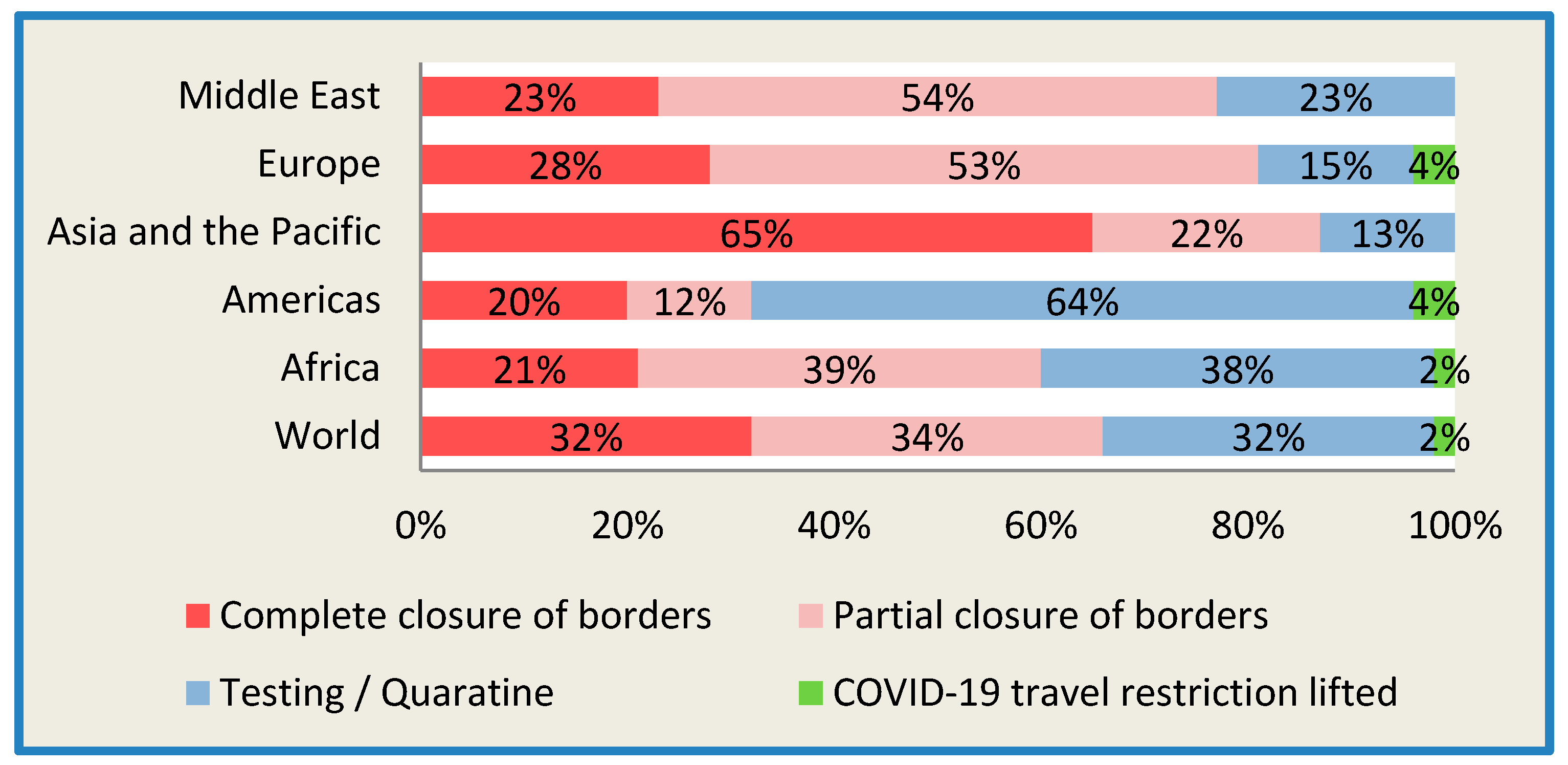
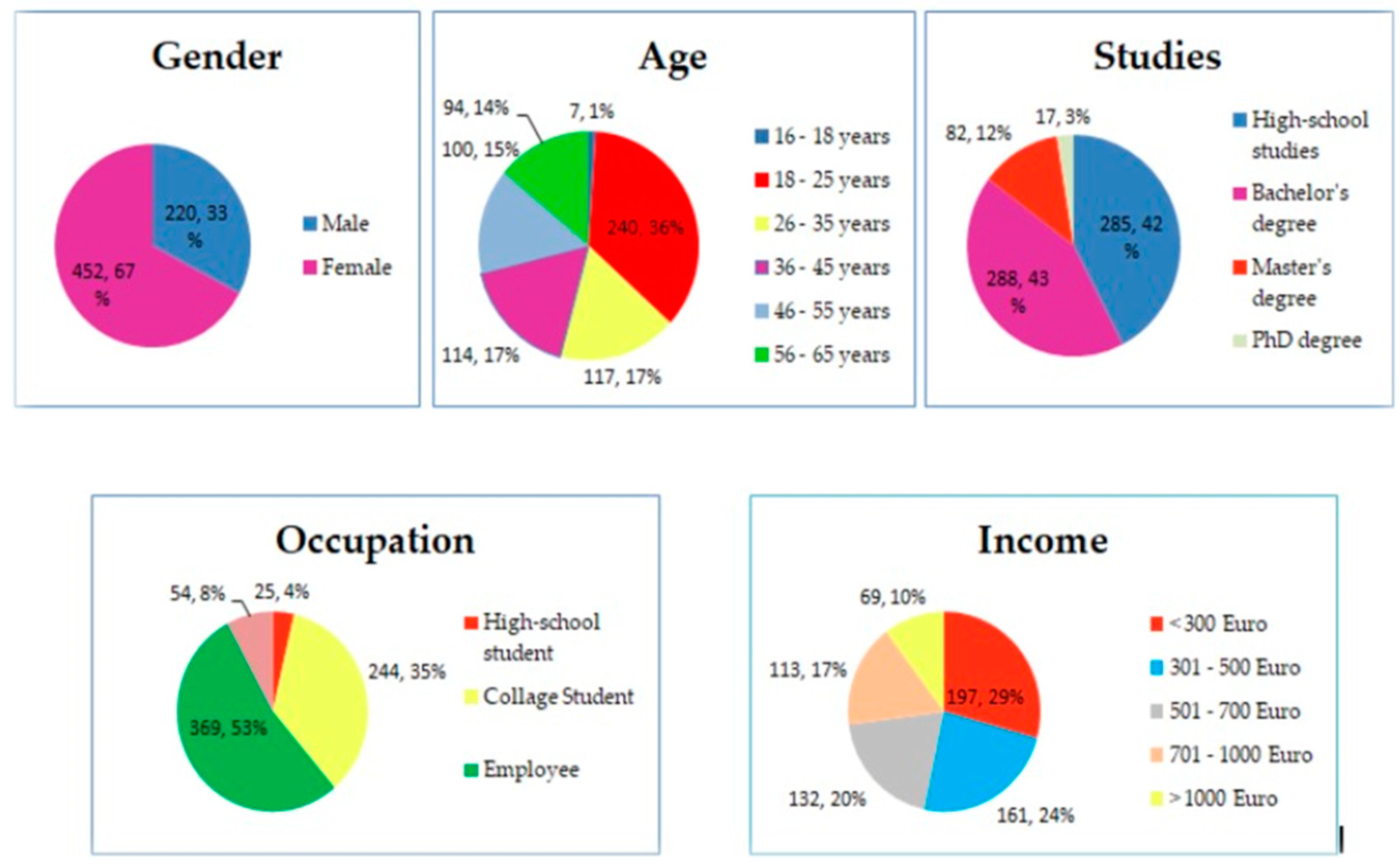
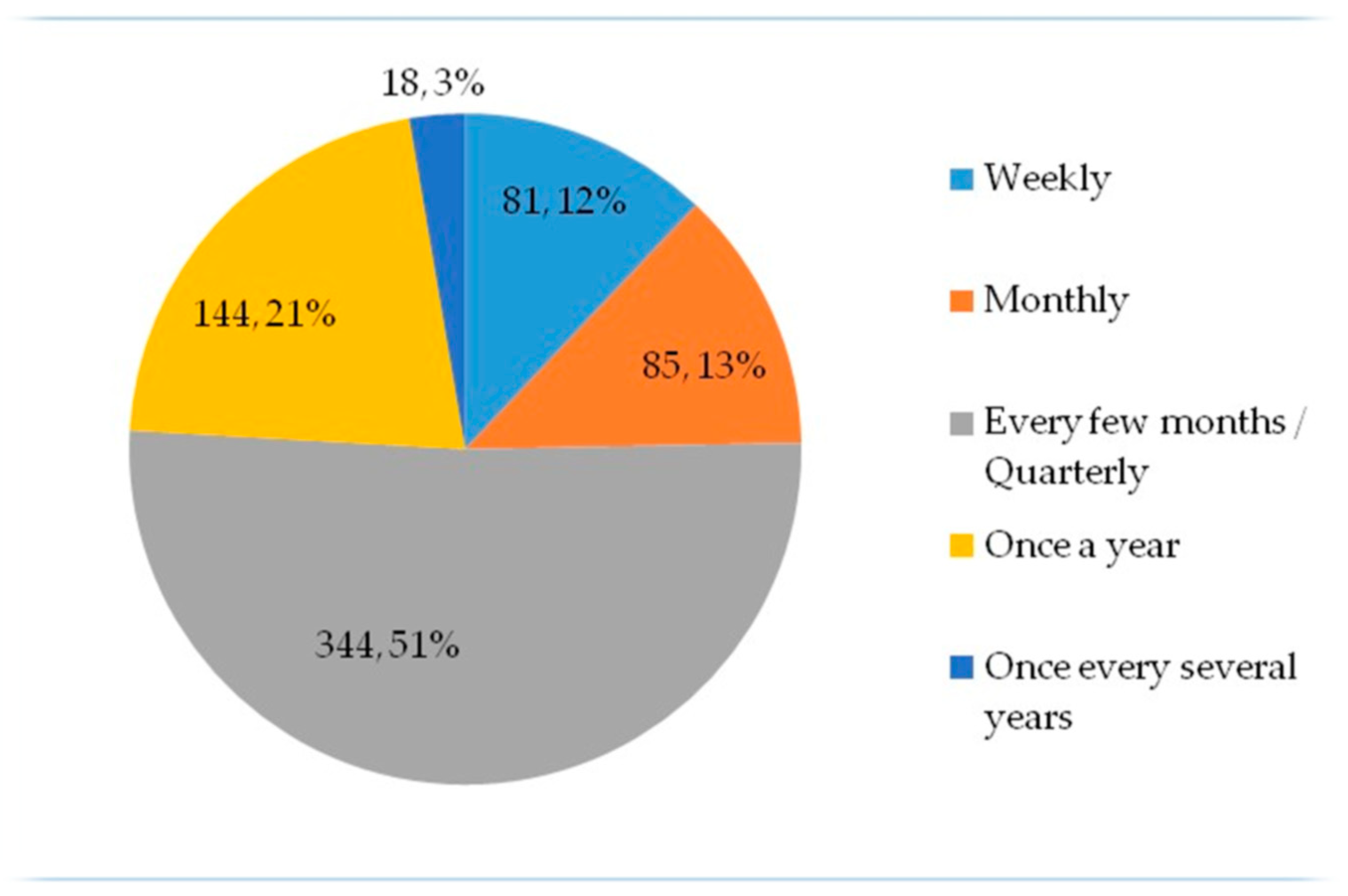
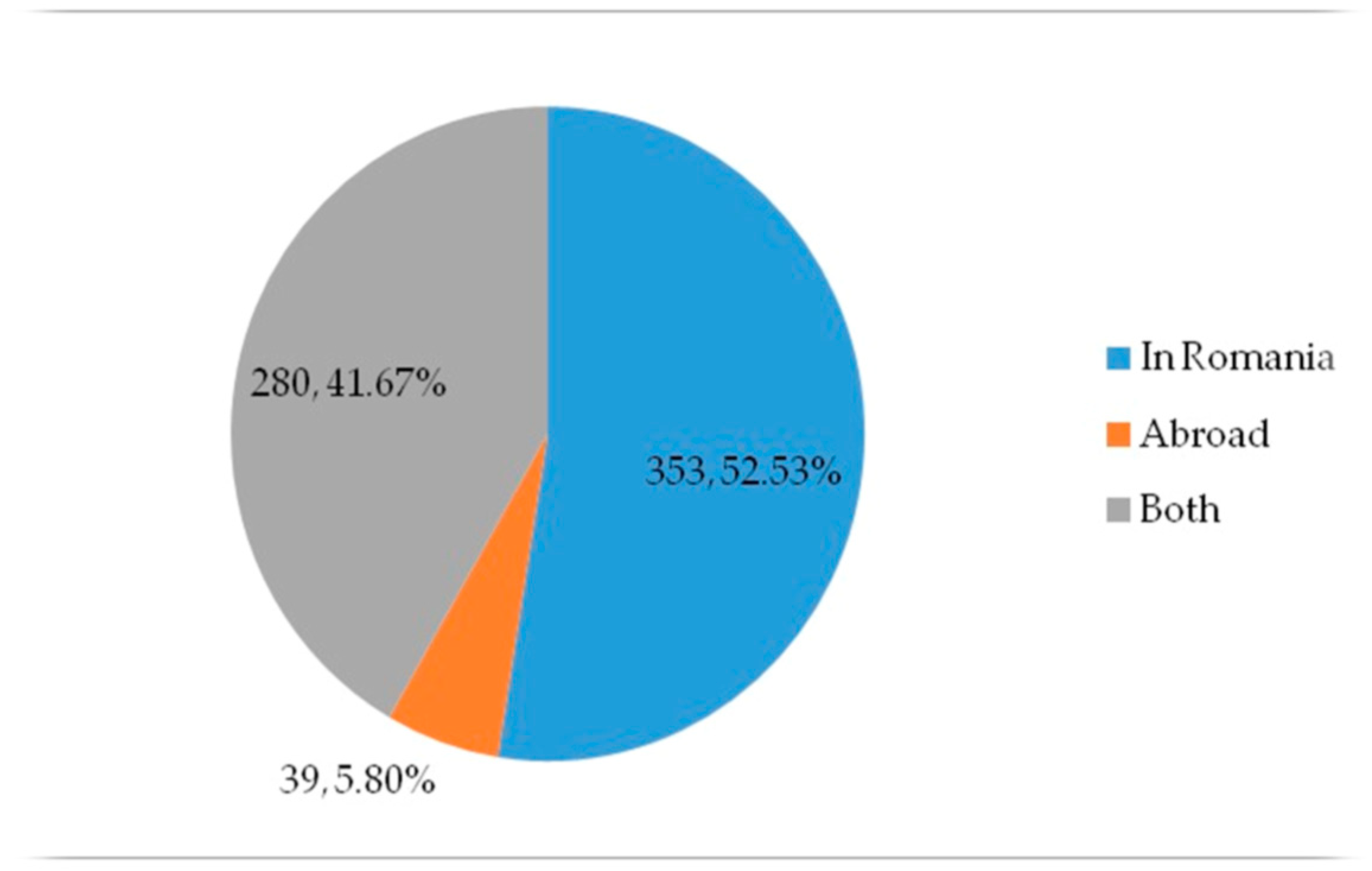

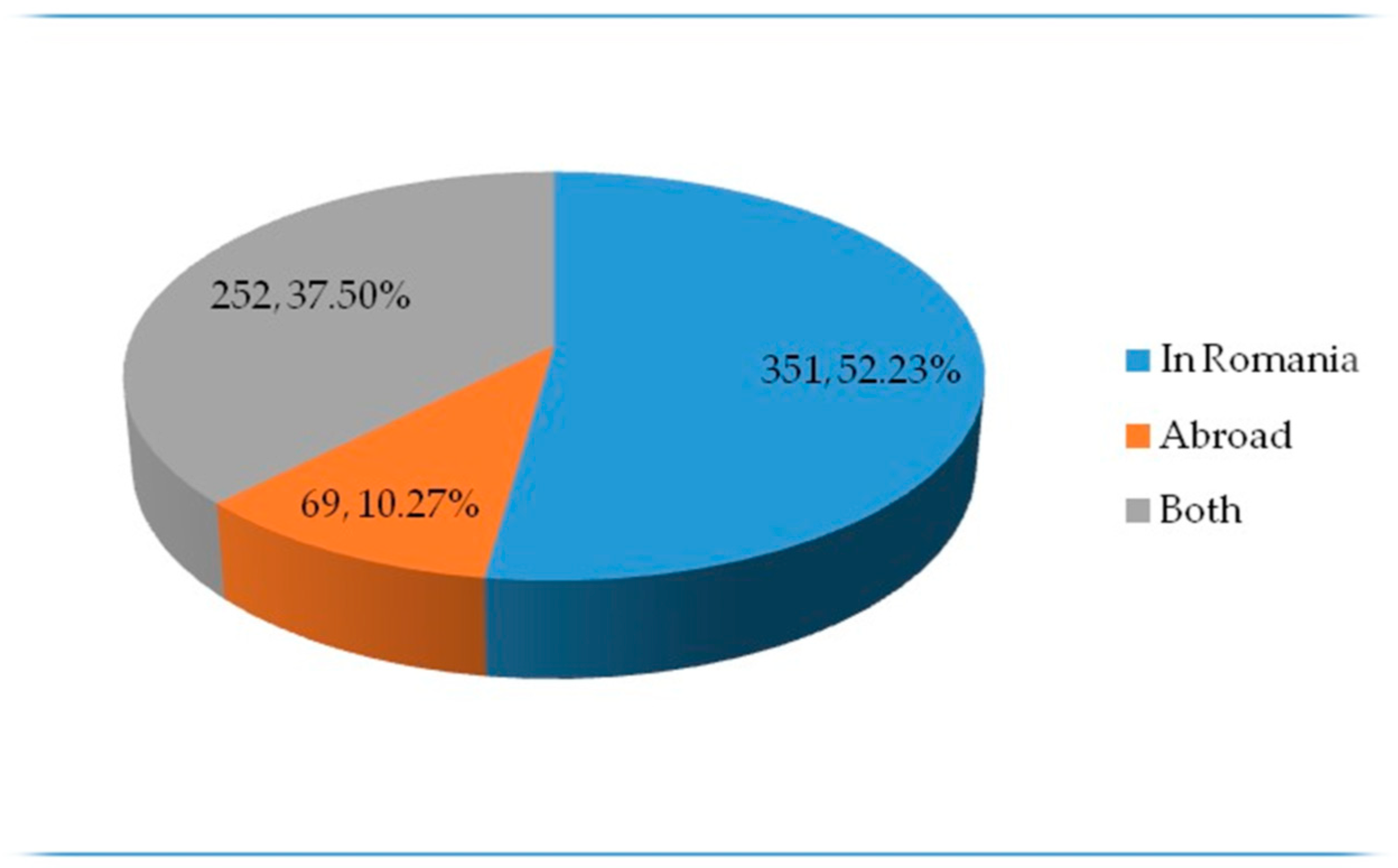
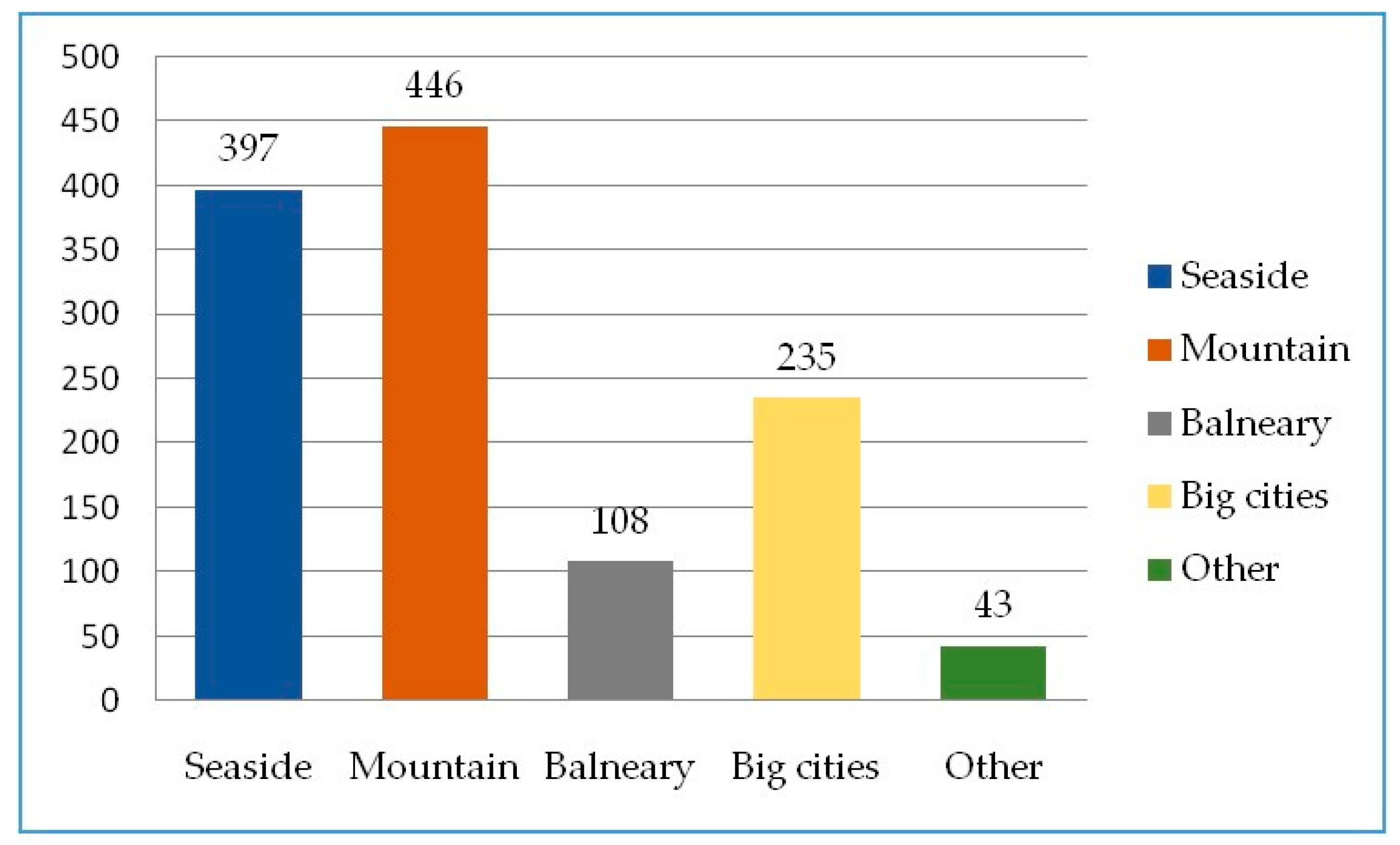
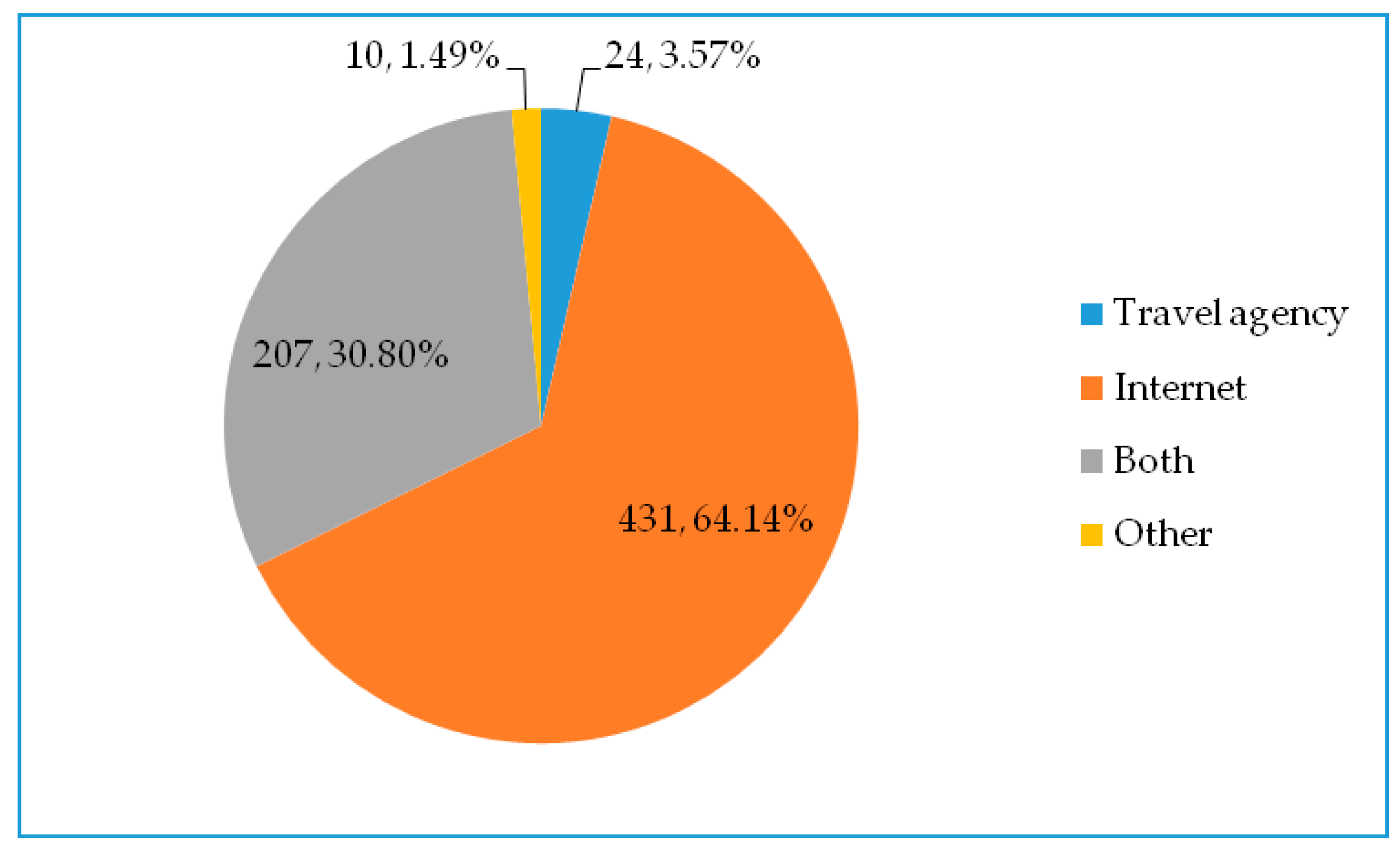
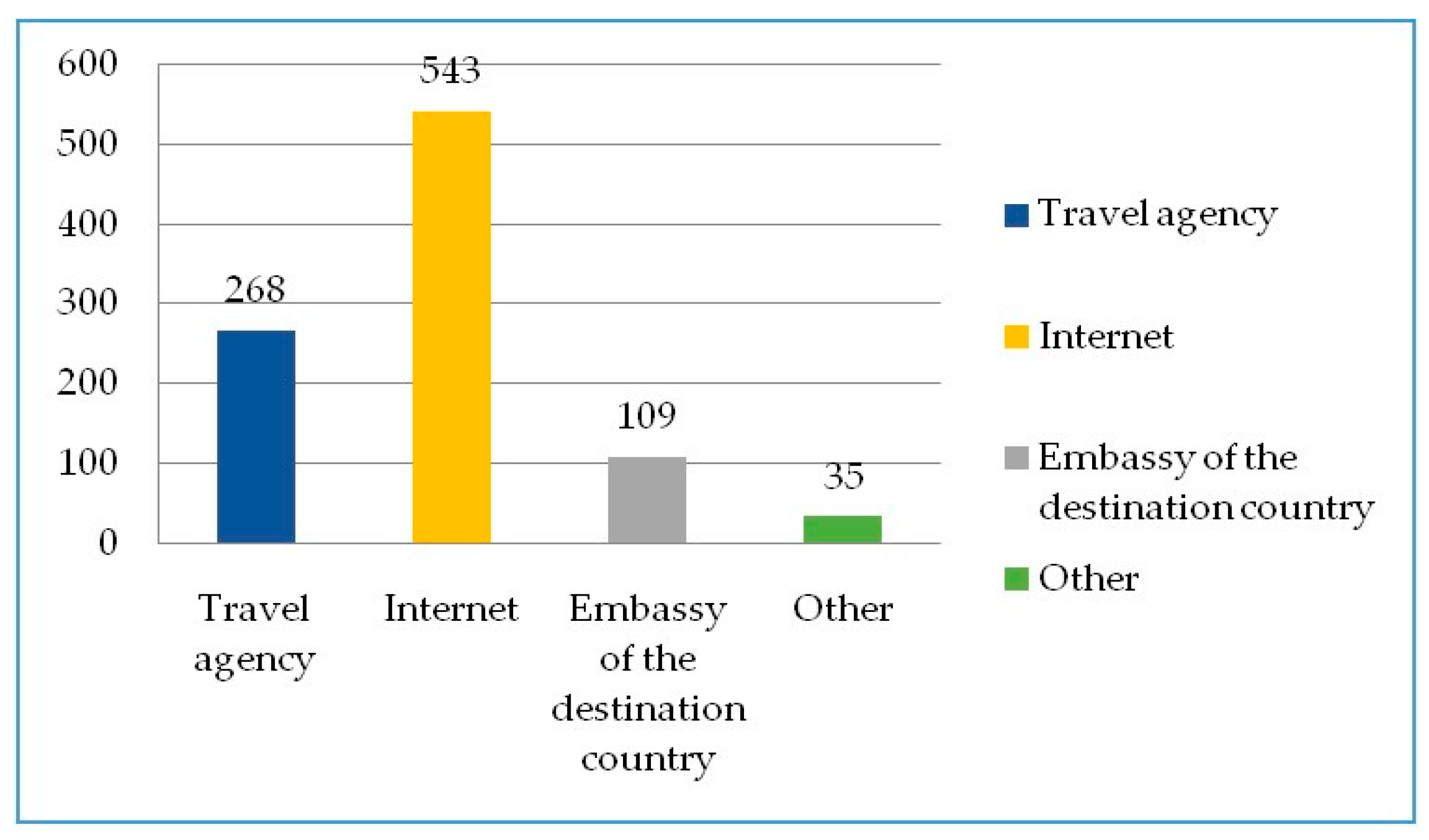


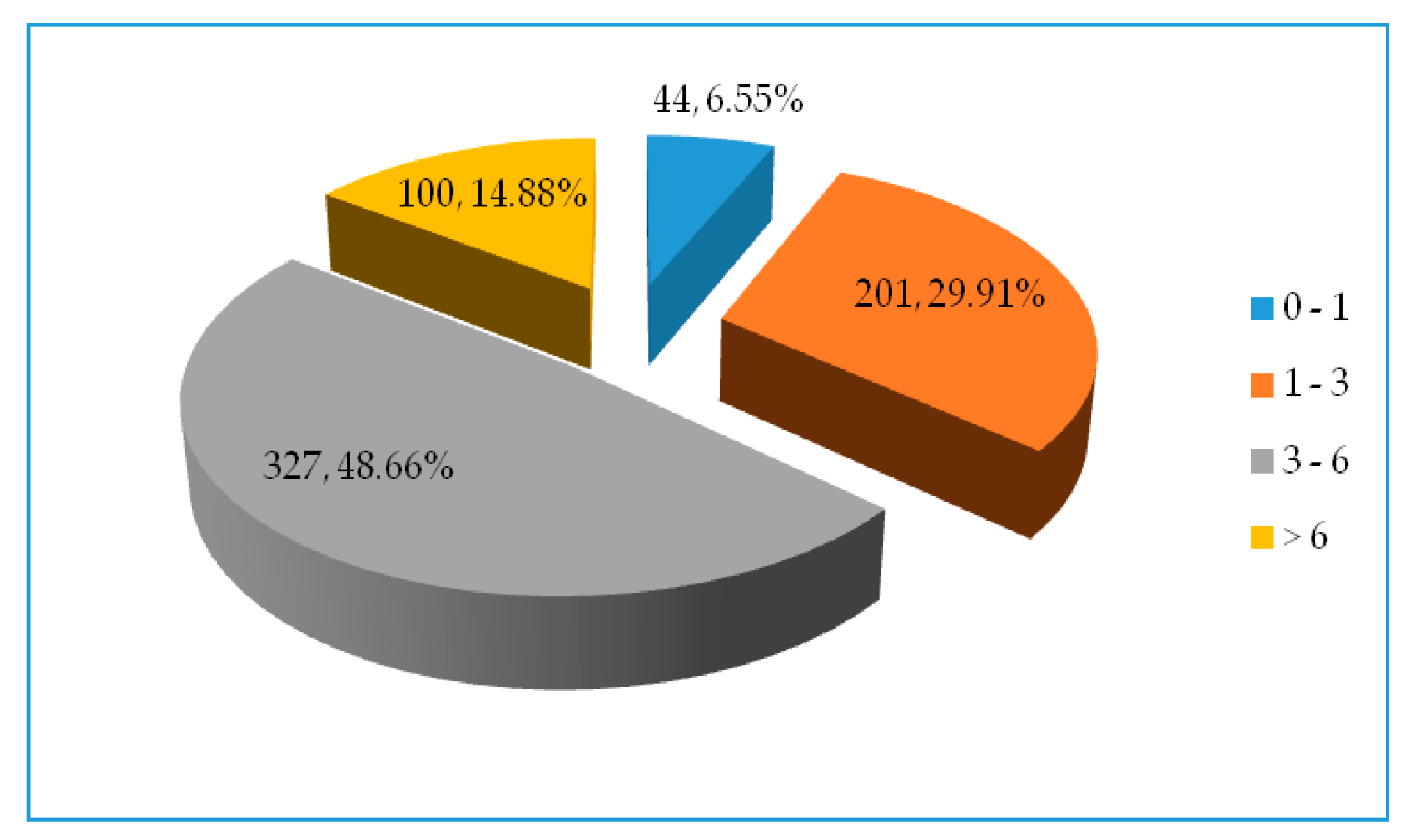

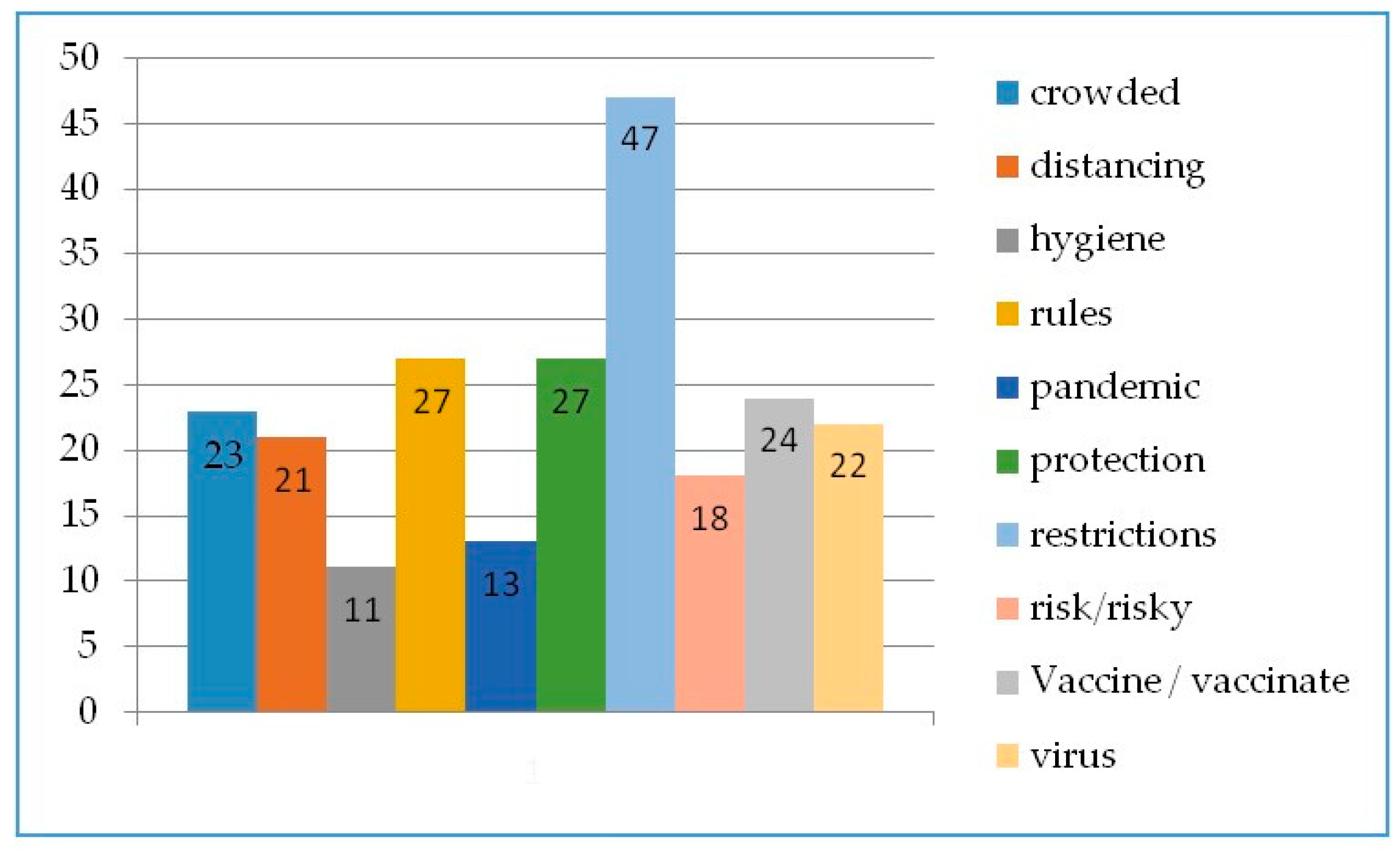
| Specification | n = 672 | % | |
|---|---|---|---|
| Sex | Male | 220 | 32.70% |
| Female | 452 | 67.30% | |
| Age | 16–18 years | 7 | 1% |
| 18–25 years | 240 | 35.70% | |
| 26–35 years | 117 | 17.40% | |
| 36–45 years | 114 | 17% | |
| 46–55 years | 100 | 14.90% | |
| 56–65 years | 94 | 14% | |
| Studies | High school studies | 285 | 42.40% |
| Bachelor’s degree | 288 | 42.90% | |
| Master’s degree | 82 | 12.20% | |
| PhD degree | 17 | 2.50% | |
| Occupation | High-school student | 25 | 3.70% |
| College Student | 244 | 33.30% | |
| Employee | 369 | 54.90% | |
| Freelance worker | 54 | 8.00% | |
| Income | <300 EUR | 197 | 29.30% |
| 301–500 EUR | 161 | 24% | |
| 501–700 EUR | 132 | 19.60% | |
| 701–1000 EUR | 113 | 16.80% | |
| >1000 EUR | 69 | 10.30% |
| Scale | Assessment according to the Importance of the Conditions that the Tourist Destination Must Meet during the Health Crisis Caused by the SARS-CoV-2 Virus: On a Scale of 1 to 5 (1 Very Unimportant and 5 Very Important) | ||||
|---|---|---|---|---|---|
| Accommodation Units Must Comply with Health Protection Regulations | Food Units Must Comply with Health Protection Regulations | Staff Should Be Vaccinated | The Other Tourists Should Be Vaccinated | The Infection Rate of the Area Should Be Less than 3 per 1000 Inhabitants | |
| 1 | 8 | 8 | 152 | 157 | 64 |
| 2 | 22 | 15 | 82 | 103 | 70 |
| 3 | 96 | 94 | 135 | 141 | 157 |
| 4 | 174 | 179 | 123 | 124 | 157 |
| 5 | 372 | 376 | 180 | 147 | 224 |
| Total | 672 | 672 | 672 | 672 | 672 |
| Score | 4.30 | 4.34 | 3.14 | 3.01 | 3.60 |
| Perception of Travel for Tourism in the Next Period Marked by the Health Crisis Caused by the SARS-CoV-2 Virus | |
|---|---|
| 1 | A short trip, max 3–4 nights, probably in an area where a negative PCR test is required for my safety and that of those around me, where safety measures are followed. Accommodation in a hotel with restaurant. If I leave the country, I would opt for a country that does not involve quarantine when returning to Romania (e.g., Turkey). |
| 2 | I consider that in the next period it will be difficult to travel if the appropriate measures are not taken in the tourism areas. The person who plans the trip wants to have information regarding the created conditions. |
| 3 | Sure enough, if I am vaccinated. I consider that people will travel more to Romania, not because of the fact that better sanitation conditions are offered, but because they are closer to home, know the pandemic situation better in their country, they can be more easily informed about the spread of the virus, and the costs of a possible postponement of the holiday involve lower costs than if they were traveling abroad. The trip will have a more recreational purpose, limited to a duration of 1–2 days, at a distance not very far from the residence, in mountainous or coastal areas. |
| 4 | In this context, especially the current one with the new wave of infections, this tourism year will not be a very good one, probably like last year. |
| 5 | For me, the vision does not change. Vacation means relaxation and good mood. I will not go on vacation to places where stress and restrictions are high. I will go on vacation to places where everything is normal or as close to normal as possible. |
| 6 | Much more limited in all respects, with far fewer attractions and visits and probably a greater openness towards nature. |
| 7 | Hello! The only difference from past travel is compliance with COVID-19 infection prevention measures. As long as through your own protection you protect others, everything is fine. Thank you! |
| 8 | I will tend to travel to places less frequented by other tourists. |
| 9 | There will still be a very large number of restrictions that will limit the possibilities of travel and the variety of activities that could have been carried out under normal conditions. |
| 10 | I hope that the location I have chosen respects all the sanitary protection norms. It will certainly be a holiday with more restrictions than before, but I consider it for the good of all humankind. The words that will define this holiday will be caution/carefulness, but not fear/panic. |
| Willingness to Travel in 2021 in the Context of the Current Pandemic | Accommodation Units Must Comply with Health Protection Regulations | Food Units Must Comply with Health Protection Regulations | Staff Should Be Vaccinated | The Other Tourists Should Be Vaccinated | The Infection Rate of the Area Should Be Less than 3 per 1000 Inhabitants | |
|---|---|---|---|---|---|---|
| Willingness to travel in 2021 in the context of the current pandemic | 1 | |||||
| Accommodation units must comply with health protection regulations | 0.332352888 | 1 | ||||
| Food units must comply with health protection regulations | 0.331445732 | 0.999739439 | 1 | |||
| Staff should be vaccinated | −0.031015798 | 0.651172313 | 0.658750115 | 1 | ||
| The other tourists should be vaccinated | −0.152135172 | 0.237840675 | 0.248349161 | 0.888324657 | 1 | |
| The infection rate of the area should be less than 3 per 1000 inhabitants | 0.620205722 | 0.936497524 | 0.936784478 | 0.611383558 | 0.257381129 | 1 |
| Type of Tourists | Year | Jan | Feb | Mar | Apr | May | Jun | Jul | Aug | Sep | Oct | Nov | Dec |
|---|---|---|---|---|---|---|---|---|---|---|---|---|---|
| Total | 2019 | 758,439 | 758,826 | 800,361 | 885,822 | 1,103,937 | 1,308,897 | 1,651,335 | 1,869,383 | 1,312,488 | 108,1817 | 902,837 | 834,614 |
| 2020 | 796,256 | 724,445 | 242,105 | 16,855 | 34,569 | 333,950 | 917,778 | 1,301,411 | 794,451 | 493,101 | 338,728 | 341,752 | |
| % Δ | 4.99 | −4.53 | −69.75 | −98.10 | −96.87 | −74.49 | −44.42 | −30.38 | −39.47 | −54.42 | −62.48 | −59.05 | |
| Domestic | 2019 | 618,621 | 623,876 | 631,270 | 681,807 | 831,301 | 1,022,762 | 1,350,243 | 1,557,077 | 102,4725 | 843,025 | 726,382 | 685,959 |
| 2020 | 668,636 | 603,642 | 207,885 | 15,503 | 33262 | 320,964 | 887,688 | 1,269,122 | 761,701 | 468,419 | 319,992 | 325,322 | |
| % Δ | 8.08 | −3.24 | −67.07 | −97.73 | −96.00 | −68.62 | −34.26 | −18.49 | −25.67 | −44.44 | −55.95 | −52.57 | |
| International | 2019 | 139,818 | 134,950 | 169,091 | 204,015 | 272,636 | 286,135 | 301,092 | 312,306 | 287,763 | 238,792 | 176,455 | 148,655 |
| 2020 | 127,620 | 120,803 | 34,220 | 1352 | 1307 | 12,986 | 30,090 | 32,289 | 32,750 | 24,682 | 18,736 | 16,430 | |
| % Δ | −8.72 | −10.48 | −79.76 | −99.34 | −99.52 | −95.46 | −90.01 | −89.66 | −88.62 | −89.66 | −89.38 | −88.95 |
| Touristic Destinations | Type of Tourists | 2019 | 2020 | % Δ |
|---|---|---|---|---|
| Total | Total | 13,374,943 | 6,398,642 | −52.16 |
| Domestic | 10,691,195 | 5,944,775 | −44.40 | |
| International | 2,683,748 | 453,867 | −83.09 | |
| Spas | Total | 1,133,359 | 601,326 | −46.94 |
| Domestic | 1,098,706 | 595,762 | −45.78 | |
| International | 34,653 | 5564 | −83.94 | |
| Seaside. excluding Constanta town | Total | 1,153,682 | 905,266 | −21.53 |
| Domestic | 1,119,401 | 899,104 | −19.68 | |
| International | 34,281 | 6162 | −82.03 | |
| Mountain resorts | Total | 2,305,517 | 1,295,105 | −43.83 |
| Domestic | 2,109,378 | 1,269,109 | −39.83 | |
| International | 196,139 | 25,996 | −86.75 | |
| Danube Delta area. including Tulcea town | Total | 166,411 | 118,325 | −28.90 |
| Domestic | 146,006 | 116,797 | −20.01 | |
| International | 20,405 | 1528 | −92.51 | |
| Bucharest and county residence town. excluding Tulcea | Total | 6,275,835 | 2,359,090 | −62.41 |
| Domestic | 4,209,530 | 1,994,058 | −52.63 | |
| International | 2,066,305 | 365,032 | −82.33 | |
| Other localities and touristic routes | Total | 2,340,139 | 1,119,530 | −52.16 |
| Domestic | 2,008,174 | 1,069,945 | −46.72 | |
| International | 331,965 | 49,585 | −85.06 |
| Year 2019 | Year 2020 | |
|---|---|---|
| Mean | 1,030,024.714 | 621,886.8571 |
| Variance | 1.04326 × 1011 | 1.33718 × 1011 |
| Observations | 7 | 7 |
| Pearson Correlation | 0.917342298 | |
| Hypothesized Mean Difference | 0 | |
| df | 6 | |
| t Stat | 7.390696935 | |
| P(T ≤ t) one-tail | 0.000157468 | |
| t Critical one-tail | 1.943180274 | |
| P(T ≤ t) two-tail | 0.000314936 | |
| t Critical two-tail | 2.446911846 |
Publisher’s Note: MDPI stays neutral with regard to jurisdictional claims in published maps and institutional affiliations. |
© 2021 by the authors. Licensee MDPI, Basel, Switzerland. This article is an open access article distributed under the terms and conditions of the Creative Commons Attribution (CC BY) license (https://creativecommons.org/licenses/by/4.0/).
Share and Cite
Cretu, C.-M.; Turtureanu, A.-G.; Sirbu, C.-G.; Chitu, F.; Marinescu, E.Ş.; Talaghir, L.-G.; Robu, D.M. Tourists’ Perceptions Regarding Traveling for Recreational or Leisure Purposes in Times of Health Crisis. Sustainability 2021, 13, 8405. https://doi.org/10.3390/su13158405
Cretu C-M, Turtureanu A-G, Sirbu C-G, Chitu F, Marinescu EŞ, Talaghir L-G, Robu DM. Tourists’ Perceptions Regarding Traveling for Recreational or Leisure Purposes in Times of Health Crisis. Sustainability. 2021; 13(15):8405. https://doi.org/10.3390/su13158405
Chicago/Turabian StyleCretu, Carmen-Mihaela, Anca-Gabriela Turtureanu, Carmen-Gabriela Sirbu, Florentina Chitu, Emanuel Ştefan Marinescu, Laurentiu-Gabriel Talaghir, and Daniela Monica Robu. 2021. "Tourists’ Perceptions Regarding Traveling for Recreational or Leisure Purposes in Times of Health Crisis" Sustainability 13, no. 15: 8405. https://doi.org/10.3390/su13158405
APA StyleCretu, C.-M., Turtureanu, A.-G., Sirbu, C.-G., Chitu, F., Marinescu, E. Ş., Talaghir, L.-G., & Robu, D. M. (2021). Tourists’ Perceptions Regarding Traveling for Recreational or Leisure Purposes in Times of Health Crisis. Sustainability, 13(15), 8405. https://doi.org/10.3390/su13158405










